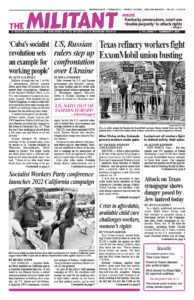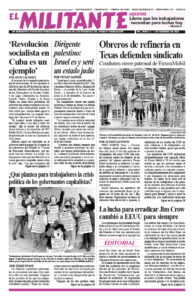Erin Turner recently started working 12-hour shifts in Iowa to cover the $1,520 a month she spends on child care for her two young children, more then twice her rent. “We’re already living within our means. We don’t have anywhere else to cut back,” she told the Wall Street Journal in a Jan. 17 article.
Brittany Graham, another Iowa worker, spent more than four months looking for child care for her 1-and- one-half-year-old daughter. Hoping to have a second child, Graham is already looking at her options. One center told her she was the 120th on the waiting list. “By the time you give me a call, my child won’t be an infant anymore,” she said.
What Turner and Graham describe are just two examples of the challenges confronting millions of young workers who hope to start a family — a prospect the crisis of capitalism is making harder and harder.
Since the COVID-19 pandemic more than 3 million women in the U.S. have lost their jobs. Many had to choose between showing up for work or caring for their kids when child care centers and schools closed. At the same time, the cost of child care has risen nearly 50% since the start of the pandemic. Families depending on two incomes are left scrambling.
Some workers are fighting for a solution. Last-minute demands by bosses for overtime is one of the issues that led 175 members of the Bakery, Confectionery, Tobacco Workers and Grain Millers Local 37, the majority women, to strike against Jon Donaire bakery in Santa Fe Springs, California. Workers on the picket line say they are not told about overtime until the end of their shift, thus making arrangements for child care nearly impossible.
Under capitalism, obtaining what workers need is an uphill fight. Bosses see us as a set of hands they can use to turn a profit. If they can’t, they’ll move on to others. Children and the elderly have no value to them. One reflection of that is the measly median pay for child care workers — $12 an hour.
Bosses are intrinsically opposed to equal treatment, and look for any opportunity to roll back or slow down the fight for women’s rights. They prize the opportunity to pay women less in order to drive down all workers’ wages. Integral to capitalist rule is their push to keep divisions between men and women in place.
Under capitalism, the emancipation of women — the right to fully participate in society, including when you have children — becomes ever more challenging. Opening the road to the battle to end women’s oppression requires the working class taking power.
Following the Bolshevik-led 1917 Russian Revolution, advances were made that set an example for women and working people today. Laws were quickly passed granting women the right to vote and the right of divorce. Nurseries were organized for the children of factory workers.
“There can be no socialist revolution,” Bolshevik leader V.I. Lenin said, “unless very many working women take a big part in it.” By setting up “public catering establishments, nurseries, kindergartens,” he said, we have the everyday means “which can really emancipate women.” Under capitalism, he noted, these steps are a rarity and run as profit-making enterprises.
Cuba’s socialist revolution offers another example. After workers and farmers took power, they overturned capitalist property relations. Led by their revolutionary government, they changed their conditions, taking over running the factories, fields and banks.
Establishing child care centers was one of the responsibilities taken up by the Federation of Cuban Women (FMC). Throughout 1960 and 1961, it collected money for them.
“We asked people to pay 3 cents more for each cup of coffee. The extra money was a donation for the children’s circles,” Vilma Espín, a leader of the revolution and head of the FMC explained. From the beginning, “we had a clear concept of how important it was to take good care of children — to look after their health, and nutrition, to keep them from getting sick and to give them love.” Significant gains were made in the revolutionary state organizing to take responsibility for children’s needs.
In 1986, buoyed by the participation of thousands of Cuban internationalists in revolutionary struggles in Angola and elsewhere, the Cuban government organized working people to take the lead in confronting challenges in meeting basic social needs, such as housing, child care and health clinics. Volunteer construction brigades were organized — part of a broader political battle waged by the revolution’s leadership to improve conditions and to combat bureaucratic privilege and corruption.
What became known as “rectification” in Cuba took on the character of a growing social movement. One result was a rise in capacity of child care centers from 96,000 to 149,000 children in just six years. Today close to a million children under age 6 in Cuba attend a learning facility and, according to the United Nations Children’s Fund, the country is leading the way on early childhood development.
This fight was part of opening the door to women’s ability to lead in advancing the revolution, including access to contraception, free and available health care and the decriminalization of abortion. In this case, the example points the way for workers and farmers in the U.S. and worldwide to chart a course to take political power into our own hands.

